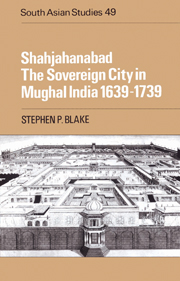1 - City and Empire
Published online by Cambridge University Press: 06 January 2010
Summary
Shahjahanabad, the capital city of the Mughal Empire, occupied a prominent spot in the Delhi triangle. Within the watersheds of both the Jamuna and Indus rivers, the Delhi triangle had been the preeminent site for the capitals of North India empires for over six hundred years. It was an area steeped in the glorious traditions of the past and Shahjahanabad was the last in a long line of premodern capital cities. The Mughal capital was the culmination of a period of urban development that began to the north in the Indus Valley about 2000 B.C. and continued until about A.D. 1750, when both Shahjahanabad and the Mughal Empire collapsed. In the almost unbroken succession of urban settlements in the Delhi area, Shahjahanabad was the crown jewel, the climax of the premodern urban process in the Indian subcontinent.
The Mughal Empire (1526–1739) was the last of the great premodern Indian empires. It was direct heir to the Mauryan and Gupta Empires, earlier states that had also aspired to subcontinental dominance. The Mughals, however, surpassed all other premodern Indian polities in the efficiency and extent of their rule and in the strength of the order which they imposed. The British followed the Mughals and, for many years, saw themselves as successors, attempting to rebuild the rotten imperial structure which they had so easily toppled.
- Type
- Chapter
- Information
- ShahjahanabadThe Sovereign City in Mughal India 1639–1739, pp. 1 - 25Publisher: Cambridge University PressPrint publication year: 1991

